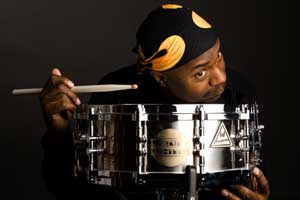No Confusion: NYC Super Drummer Lenny White is On Top with ‘Anamoly’
RIVER EDGE, NEW JERSEY: Virtuoso lovers, take note: Lenny White has a new album out. It’s an intense musical experience, and it’s called Anomaly.
 The native New Yorker, who was a member of the galactic-class drum/percussion team of Miles Davis’ Bitches Brew, fuses on with his first personal release in a decade. Following a successful reunion tour with Return to Forever in 2008, plus 2009 stints touring with Chick Corea, Hiromi and Stanley Clarke, White got back to writing and pulled even more powerful names into the 12-track project.
The native New Yorker, who was a member of the galactic-class drum/percussion team of Miles Davis’ Bitches Brew, fuses on with his first personal release in a decade. Following a successful reunion tour with Return to Forever in 2008, plus 2009 stints touring with Chick Corea, Hiromi and Stanley Clarke, White got back to writing and pulled even more powerful names into the 12-track project.
Released last week on Abstract Logix, Anamoly features an incredible roster of guest artists: guitarists Jimmy Herring (Widespread Panic), Nick Moroch (a former member of White’s Astral Pirates), David Gilmore, Tom Guarna and David Bendeth; keyboardists George Colligan, Bernard Wright, Donald Blackman (also an Astral Pirate) and Vince Evans; bassists Victor Bailey, Richie Goods, Charles Fambrough and aforementioned Return to Forever teammate Stanley Clarke.
Tantalized? Best ye be. Many instant classics are apparent on Anomaly, a record where White had specific goals which drove the groove-thick structures and rich improv. Mind-blowing drums abound as well, such as the outrageous polyrhythmic fun White has on “Gazelle”, followed directly by the sugar sweet rolls he wields on “If U Dare”. The duet playing with Mike Clark on “CatLett Out of the Bag” delivers on that pairing’s amazing possibilities.
“I wanted to make a record with some progressive playing that didn’t sound like ‘fusion,’” White says. “What I played there is fusion, though, not just jazz rock. I make a distinction. It’s rockin’, but you could play a jazz ride over all those beats that I played. It’s got a little swing to it.”
One of New York City’s great musical mentors told SonicScoop about the plans behind Anamoly.
Q: How did you approach the production of your new album?
A: I’m a huge movie fan. And I approach making records the way a director would approach making a movie. I think of a song as a scene. When you have a screenplay, you call certain actors to render your scene. If you’re fortunate enough to have friends who are iconic music people, you call them. I look at it like that.
This way, if I tell the musicians, “This is what I was thinking: I was thinking about a girl standing on the shore with the wind blowing her hair,” I know they get it. If you pick the right actor, he or she knows what to do. I do the same with musicians.
Q: Where was Anomaly recorded?
A: The album was recorded at Knoop Music in River Edge, NJ except for one song, “We Know”, which was done at House of Loud, David Bendeth’s studio.
Manfred Knoop is my friend – I’ve done about five albums there and it’s a really, really great space. He has an Amek console, and we recorded into Pro Tools.
I knew what I wanted to get sonically. I don’t think any record is any better than its drum sound. If the drums sound great, everyone says the record sounds amazing. If the drums don’t sound right, the record doesn’t sound right. I’ve done enough records to know what I want to get out of my instrument.
The way records sound today — it’s not an open sound. I think that jazz music, classical music, and vintage rock and roll music are similar in the sense that you can hear the ambient air around the music. With classical music, if you hear a piano or an orchestra, it’s not direct-miking, it’s ambient. The jazz records I heard were ambient sounds. Led Zeppelin, the drums sound huge, because there’s air around it — it’s not a tight, pillow-in- the-bass-drum sound.
So I was looking for all of those sensibilities, not just from the he standpoint of that’s where I’m from, but also from the standpoint that it’s not what’s happening today – really open-sounding drums are different.
Q: What’s the key to achieving that sound?
A: Kind of the way you play! And how you mic things. I used a lot of ribbon mics, mics on my cymbals…different things.
Q: Drilling down into that, how did you and Manfred approach mic placement?
A: Again, I wanted it to breathe, I wanted to have some air around the music, there were some things I miked tighter and closer than others. I used three drumsets on the recording. I used a different drumset on the track “CatLett Out of the Bag” with Mike Clark and myself, and a bigger drumset on the last tune which is “The Wait Has Lifted the Weight”. Everything else was the same drumset, but that kit sounds like different drumsets — it’s just about how you mic it.
Q: Can you tell us more about the drumset you used the most?
A: Innovation Drums. The kit is a 20” x 20” bass drum, 5 ½” x 14” titanium snare drum. The toms are 8” x 12”, 9” x 13”, 14” x 14”, 16” x 16”.
I had gone out in 2008 with Return to Forever, with the big kit again. I got inspired by that. Every night I’d go out and say, “This is not a boy band, this is a man’s band.” I really wanted to play some balls-to-the-wall music. There are rock drummers who use bigger drums, but I had a revelation a long time ago: I spoke with Buddy Miles, and said, “What size bass drum did you use on Band of Gypsies?” He said it was a 20”. I was surprised – I thought it was like John Bonham’s, which was what – 26 inches?
Q: So it sounds like that means capturing the kick, first and foremost, is extra important.
A: It depends on the recording and the artist, but if you listen to the Power Station records, David Bowie’s Let’s Dance, the kick is right up there. Even some of the later Tony Williams records, the bass drum is right up there. I don’t like it when it’s just a snare drum record. That’s not me. – David Weiss
Please note: When you buy products through links on this page, we may earn an affiliate commission.








Pablo Arraya
May 27, 2010 at 11:13 pm (14 years ago)We got to mix two songs off this record. Lenny is the man. He is not only an amazing drummer. A true gentleman, teacher, and amazing producer with a very deep vision. Glad this album is getting he exposure it deserves.
Pablo Arraya
May 27, 2010 at 4:13 pm (14 years ago)We got to mix two songs off this record. Lenny is the man. He is not only an amazing drummer. A true gentleman, teacher, and amazing producer with a very deep vision. Glad this album is getting he exposure it deserves.